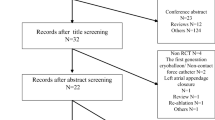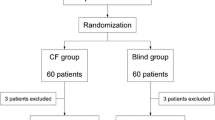Abstract
Background
Catheter ablation for atrial fibrillation (AF) has become an effective treatment to control symptoms. The second generation cryoballoon (CB) was designed for more efficient and homogenous freeze. Radiofrequency (RF) ablation catheters using three-dimensional electroanatomical mapping with the use of contact-force radiofrequency (CF RF) technology has achieved good results in several studies.
Objectives
To compare the efficacy and safety of second-generation CB ablation in contrast to CF RF ablation in the ablation of paroxysmal AF.
Methods
A total of 81 consecutive patients suffering from paroxysmal AF underwent pulmonary vein isolation (PVI) either by the second generation cryoballoon (n = 44) or a contact force-sensing RF catheter (n = 37). The study was conducted at Ain Shams University Hospitals and Royal Brompton & Harefield NHS trust. Baseline data, procedural data and patient follow up—at 3, 6 and 12 months—were collected and analysed.
Results
The mean age was 53.8 ± 15 years in the CB group and 62.4 ± 12 years in the RF group, females representing 40.9% and 48.6% respectively. The baseline characteristics were comparable, but the CB group had less left atrial diameter and more left ventricular ejection fraction. The CB procedure was shorter (94.4 ± 39.3 vs. 140.8 ± 44.3 min, p < 0.0001), with longer fluoroscopy time (30 vs. 15.1 min, p = 0.047). Procedural complications were comparable between the two groups (CB 4.6%, CF RF 2.7%, p = 0.411). After 1 year, the recurrence rate in the CB group was similar to RF (27.3% vs. 27% respectively, p = 0.980).
Conclusion
Second-generation CB ablation of paroxysmal AF has similar efficacy and safety to contact force-sensing RF catheters, with shorter procedure times and more fluoroscopy.
Zusammenfassung
Hintergrund
Die Katheterablation von Vorhofflimmern ist zu einer effektiven Therapie für die Symptomkontrolle geworden. Der Kryoballon (CB) der zweiten Generation wurde für eine effizientere und homogenere Kryotherapie entwickelt. Auch Radiofrequenz(RF)-Ablationskatheter haben in verschiedenen Studien unter Nutzung des dreidimensionalen elektroanatomischen Mappings und der Contact-force-Technologie (CFRF) gute Ergebnisse erzielt.
Studienziel
Vergleich der Effektivität und Sicherheit des CB der zweiten Generation im Vergleich zu CFRF bei der Ablation von paroxysmalem Vorhofflimmern.
Methodik
Bei 81 konsekutiven Patienten mit paroxysmalem Vorhofflimmern wurde eine Pulmonalvenenisolation entweder mittels CB der zweiten Generation (n = 44) oder CFRF-Katheter (n = 37) durchgeführt. Die Studie wurde an den Ain-Shams-Universitätskliniken und am Royal Brompton & Harefield NHS Trust durchgeführt. Basisdaten, prozedurbezogene Daten und die Nachuntersuchung der Patienten nach 3, 6 und 12 Monaten wurden erhoben und analysiert.
Ergebnisse
Das mittlere Alter lag bei 53,8 ± 15 Jahren in der CB- und 62,4 ± 12 Jahren in der CFRF-Gruppe, 40,9 % bzw. 48,6 % der Patienten waren weiblich. Basischarakteristika waren vergleichbar, jedoch war in der CB-Gruppe der linksatriale Diameter geringer und die linksventrikuläre Ejektionsfraktion höher. Die CB-Prozedur war kürzer (94,4 ± 39,3 vs. 140,8 ± 44,3 min, p < 0,0001) mit längerer Fluoroskopiezeit (30 vs. 15,1 min, p = 0,047). Prozedurale Komplikationen waren vergleichbar zwischen den beiden Gruppen (CB 4,6 %, CFRF 2,7 %, p = 0,411). Nach einem Jahr waren die Rezidivraten in der CB- und CFRF-Gruppe vergleichbar (27,3 % vs. 27 %, p = 0,980).
Schlussfolgerung
Eine Ablation von paroxysmalem Vorhofflimmern mittels CB der zweiten Generation hatte eine vergleichbare Effektivität und Sicherheit wie die CFRF-Ablation, bei kürzerer Prozedur- und längerer Fluoroskopiedauer.




Similar content being viewed by others
References
Calkins H, Kuck KH, Cappato R, Brugada J, Camm AJ, Chen SA, Crijns HJ et al (2012) 2012 HRS/EHRA/ECAS expert consensus statement on catheter and surgical ablation of atrial fibrillation: recommendations for patient selection, procedural techniques, patient management and follow-up, definitions, endpoints, and research trial design: a report of the Heart Rhythm Society (HRS) Task Force on Catheter and Surgical Ablation of Atrial Fibrillation. Developed in partnership with the European Heart Rhythm Association (EHRA), a registered branch of the European Society of Cardiology (ESC) and the European Cardiac Arrhythmia Society (ECAS); and in collaboration with the American College of Cardiology (ACC), American Heart Association (AHA), the Asia Pacific Heart Rhythm Society (APHRS), and the Society of Thoracic Surgeons (STS). Endorsed by the governing bodies of the American College of Cardiology Foundation, the American Heart Association, the European Cardiac Arrhythmia Society, the European Heart Rhythm Association, the Society of Thoracic Surgeons, the Asia Pacific Heart Rhythm Society, and the Heart Rhythm Society. Heart Rhythm 9(4):632–96.e21
Thrall G, Lane D, Carroll D, Lip GY (2006) Quality of life in patients with atrial fibrillation: a systematic review. Am J Med 119(5):448.e1–448.19
Steinberg BA, Kim S, Fonarow GC, Thomas L, Ansell J, Kowey PR, Mahaffey KW et al (2014) Drivers of hospitalization for patients with atrial fibrillation: Results from the Outcomes Registry for Better Informed Treatment of Atrial Fibrillation (ORBIT-AF). Am Heart J 167(5):735–742.e2
Haïssaguerre M, Jaïs P, Shah DC, Takahashi A, Hocini M, Quiniou G, Garrigue S et al (1998) Spontaneous initiation of atrial fibrillation by ectopic beats originating in the pulmonary veins. N Engl J Med 339(10):659–666
Wazni OM, Marrouche NF, Martin DO, Verma A, Bhargava M, Saliba W, Bash D et al (2005) Radiofrequency ablation vs antiarrhythmic drugs as first-line treatment of symptomatic atrial fibrillation: a randomized trial. JAMA 293(21):2634–2640
Pappone C, Augello G, Sala S, Gugliotta F, Vicedomini G, Gulletta S, Paglino G et al (2006) A randomized trial of circumferential pulmonary vein ablation versus antiarrhythmic drug therapy in paroxysmal atrial fibrillation: the APAF Study. J Am Coll Cardiol 48(11):2340–2347
Jaïs P, Cauchemez B, Macle L, Daoud E, Khairy P, Subbiah R, Hocini M et al (2008) Catheter ablation versus antiarrhythmic drugs for atrial fibrillation: the A4 study. Circulation 118(24):2498–2505
Walfridsson H, Walfridsson U, Nielsen JC, Johannessen A, Raatikainen P, Janzon M, Levin LA et al (2015) Radiofrequency ablation as initial therapy in paroxysmal atrial fibrillation: results on health-related quality of life and symptom burden. The MANTRA-PAF trial. Europace 17(2):215–221
Natale A, Reddy VY, Monir G, Wilber DJ, Lindsay BD, McElderry HT, Kantipudi C et al (2014) Paroxysmal AF catheter ablation with a contact force sensing catheter: results of the prospective, multicenter SMART-AF trial. J Am Coll Cardiol 64(7):647–656
Martinek M, Lemes C, Sigmund E, Derndorfer M, Aichinger J, Winter S, Nesser HJ et al (2012) Clinical impact of an open-irrigated radiofrequency catheter with direct force measurement on atrial fibrillation ablation. Pacing Clin Electrophysiol 35(11):1312–1318
Cappato R, Calkins H, Chen SA, Davies W, Iesaka Y, Kalman J, Kim YH et al (2010) Updated worldwide survey on the methods, efficacy, and safety of catheter ablation for human atrial fibrillation. Circ Arrhythm Electrophysiol 3(1):32–38
Van Belle Y, Janse P, Rivero-Ayerza MJ, Thornton AS, Jessurun ER, Theuns D, Jordaens L (2007) Pulmonary vein isolation using an occluding cryoballoon for circumferential ablation: feasibility, complications, and short-term outcome. Eur Heart J 28(18):2231–2237
Kuck K‑H, Brugada J, Fürnkranz A, Metzner A, Ouyang F, Chun KR, Elvan A et al (2016) Cryoballoon or radiofrequency ablation for paroxysmal atrial fibrillation. N Engl J Med 374(23):2235–2245
Luik A, Radzewitz A, Kieser M, Walter M, Bramlage P, Hörmann P, Schmidt K et al (2015) Cryoballoon versus open irrigated radiofrequency ablation in patients with paroxysmal atrial fibrillation. Circulation 132(14):1311–1319
Hunter RJ, Baker V, Finlay MC, Duncan ER, Lovell MJ, Tayebjee MH, Ullah W et al (2015) Point-by-point radiofrequency ablation versus the cryoballoon or a novel combined approach: a randomized trial comparing 3 methods of pulmonary vein isolation for paroxysmal atrial fibrillation (the Cryo versus RF trial). J Cardiovasc Electrophysiol 26(12):1307–1314
Kirchhof P, Benussi S, Kotecha D, Ahlsson A, Atar D, Casadei B, Castella M et al (2016) 2016 ESC Guidelines for the management of atrial fibrillation developed in collaboration with EACTS. Eur J Cardiothorac Surg 50(5):e1–e88
Su W, Kowal R, Kowalski M, Metzner A, Svinarich JT, Wheelan K, Wang P (2015) Best practice guide for cryoballoon ablation in atrial fibrillation: The compilation experience of more than 3000 procedures. Heart Rhythm 12(7):1658–1666
Pappone C, Rosanio S, Oreto G, Tocchi M, Gugliotta F, Vicedomini G, Salvati A et al (2000) Circumferential radiofrequency ablation of pulmonary vein ostia: A new anatomic approach for curing atrial fibrillation. Circulation 102(21):2619–2628
Matta M, Anselmino M, Ferraris F, Scaglione M, Gaita F (2018) Cryoballoon vs. radiofrequency contact force ablation for paroxysmal atrial fibrillation: a propensity score analysis. J Cardiovasc Med 19(4):141–147
Squara F, Zhao A, Marijon E, Latcu DG, Providencia R, Di Giovanni G, Jauvert G et al (2015) Comparison between radiofrequency with contact force-sensing and second-generation cryoballoon for paroxysmal atrial fibrillation catheter ablation: a multicentre European evaluation. Europace 17(5):718–724
Yokokawa M, Chugh A, Latchamsetty R, Ghanbari H, Crawford T, Jongnarangsin K, Cunnane R et al (2018) Ablation of paroxysmal atrial fibrillation using a second-generation cryoballoon catheter or contact-force sensing radiofrequency ablation catheter: a comparison of costs and long-term clinical outcomes. J Cardiovasc Electrophysiol 29(2):284–290
Buist TJ, Adiyaman A, Smit JJJ, Ramdat Misier AR, Elvan A (2018) Arrhythmia-free survival and pulmonary vein reconnection patterns after second-generation cryoballoon and contact-force radiofrequency pulmonary vein isolation. Clin Res Cardiol 107(6):498–506
Jourda F, Providencia R, Marijon E, Bouzeman A, Hireche H, Khoueiry Z, Cardin C et al (2015) Contact-force guided radiofrequency vs. second-generation balloon cryotherapy for pulmonary vein isolation in patients with paroxysmal atrial fibrillation—a prospective evaluation. Europace 17(2):225–231
Calkins H, Hindricks G, Cappato R, Kim YH, Saad EB, Aguinaga L, Akar JG et al (2017) 2017 HRS/EHRA/ECAS/APHRS/SOLAECE expert consensus statement on catheter and surgical ablation of atrial fibrillation. Heart Rhythm 14(10):e275–e444
Natale A, Mohanty S, Goldstein L, Gomez T, Hunter TD (2020) Real-world safety of catheter ablation for atrial fibrillation with contact force or cryoballoon ablation
Straube F, Dorwarth U, Hartl S, Bunz B, Wankerl M, Ebersberger U, Hoffmann E (2016) Outcome of paroxysmal atrial fibrillation ablation with the cryoballoon using two different application times: the 4‑ versus 3‑min protocol. J Interv Card Electrophysiol 45(2):169–177
Author information
Authors and Affiliations
Corresponding author
Ethics declarations
Conflict of interest
A.N. Ali, O. Riad, M. Tawfik, A. Opel and T. Wong declare that they have no competing interests.
All procedures performed in studies involving human participants or on human tissue were in accordance with the ethical standards of the institutional (Ain Shams University ethical committee) and/or national research committee and with the 1975 Helsinki declaration and its later amendments or comparable ethical standards. Informed consent was obtained from all individual participants included in the study.
Additional information
Copyrights
All authors ensure their acceptance of transfer of copyright to the journal Herzschrittmachertherapie und Elektrophysiologie upon the acceptance of the manuscript for publication.
Rights and permissions
About this article
Cite this article
Ali, A.N., Riad, O., Tawfik, M. et al. Newer generation cryoballoon vs. contact force-sensing radiofrequency ablation catheter in the ablation of paroxysmal atrial fibrillation. Herzschr Elektrophys 32, 236–243 (2021). https://doi.org/10.1007/s00399-021-00763-6
Received:
Accepted:
Published:
Issue Date:
DOI: https://doi.org/10.1007/s00399-021-00763-6




